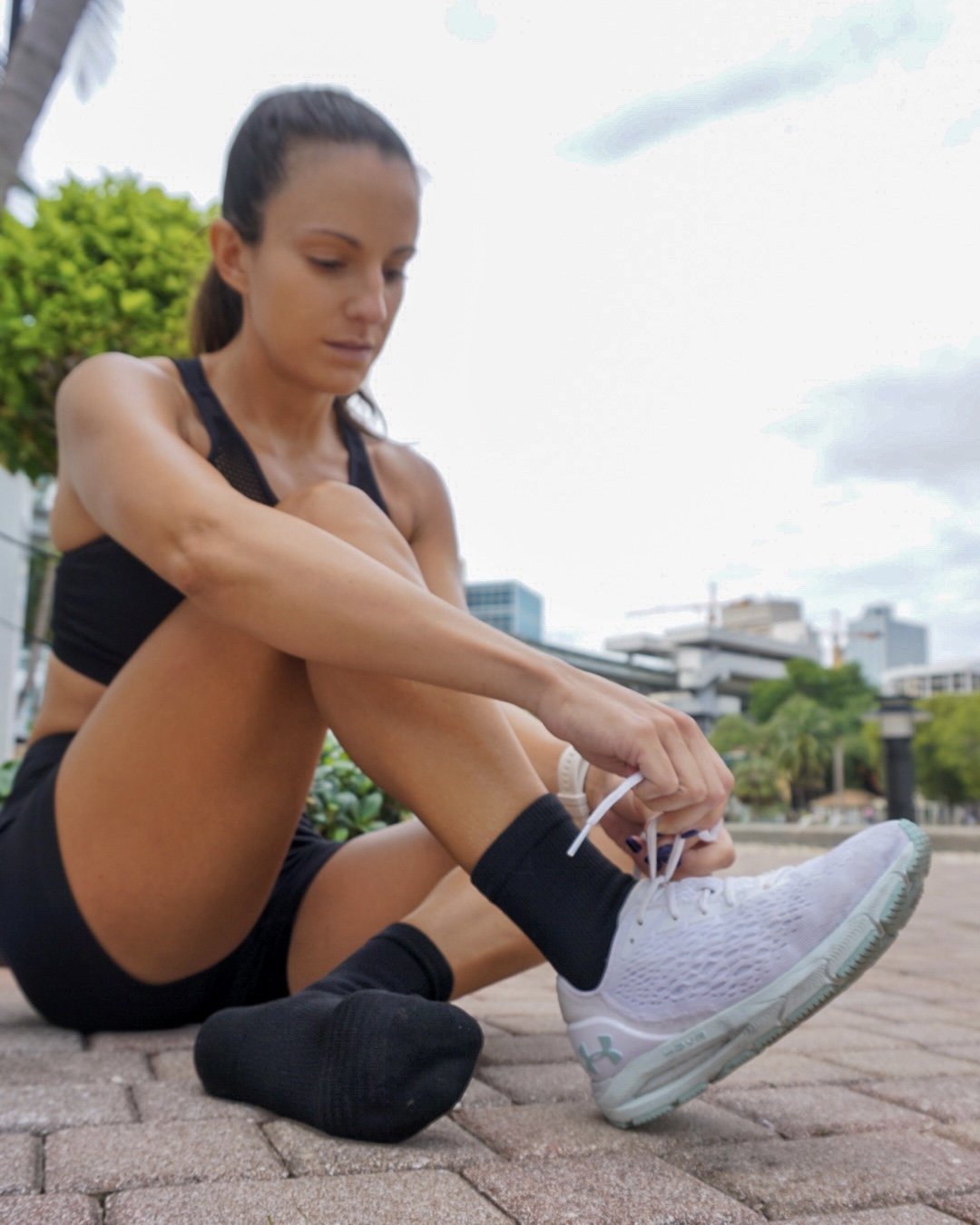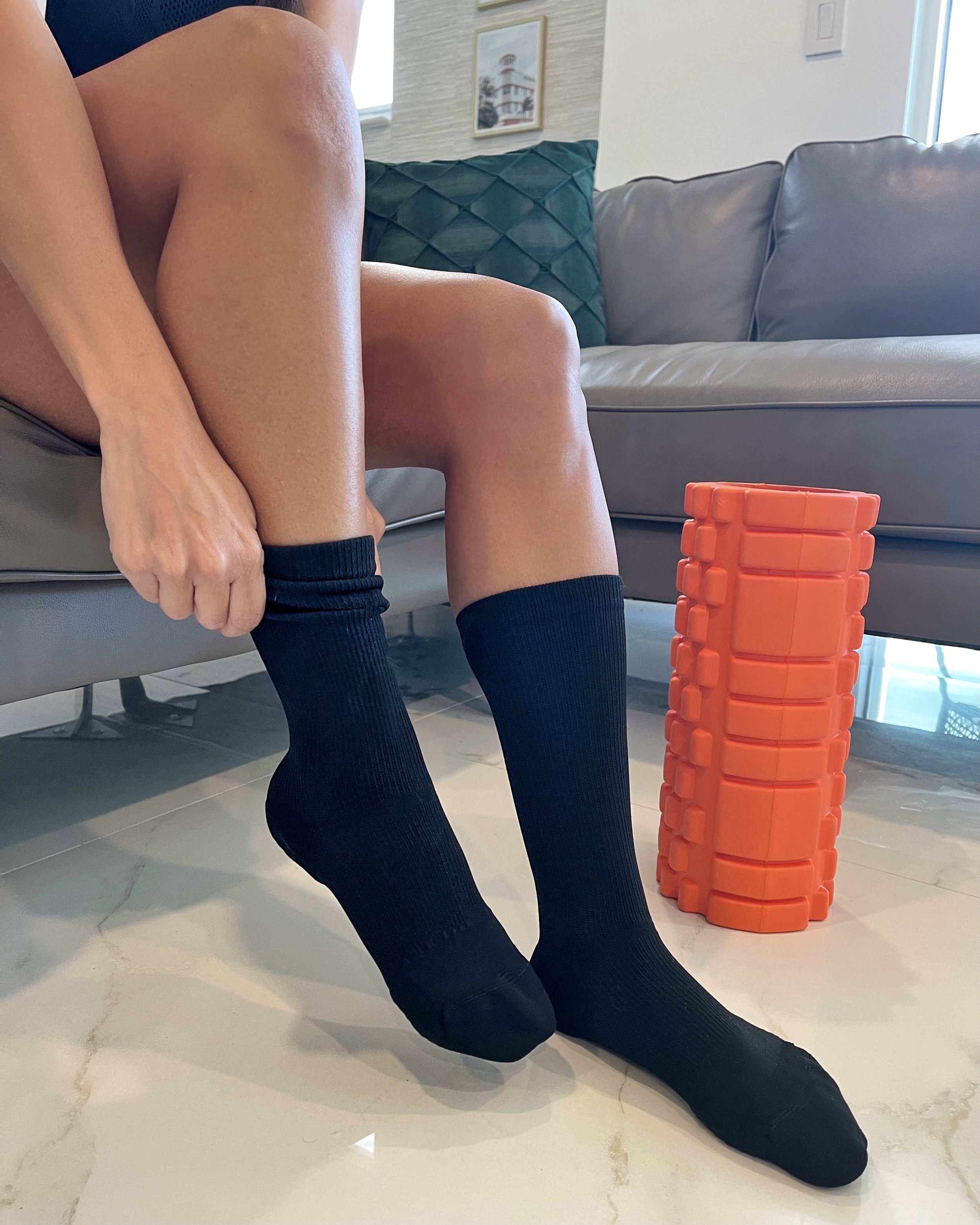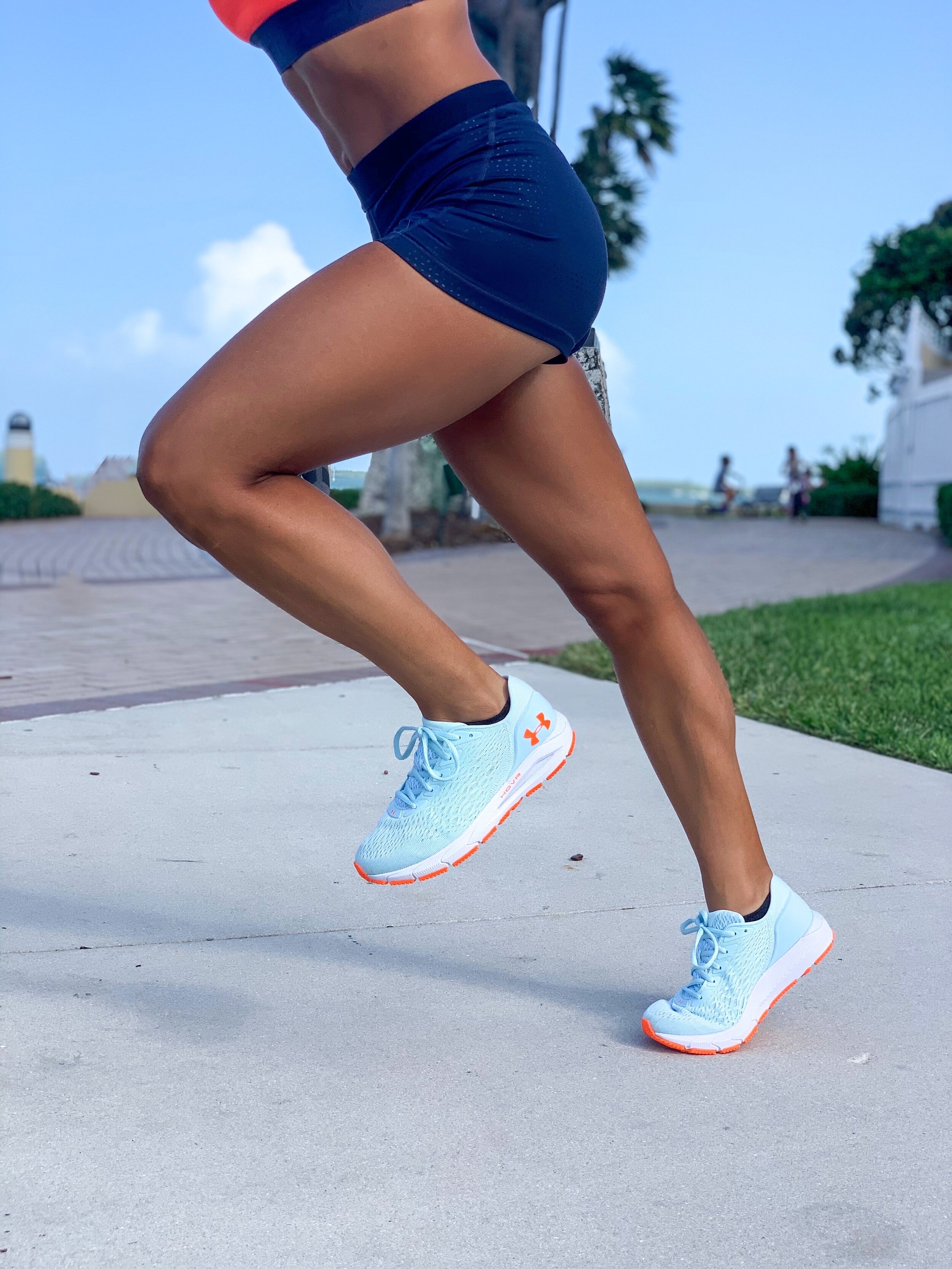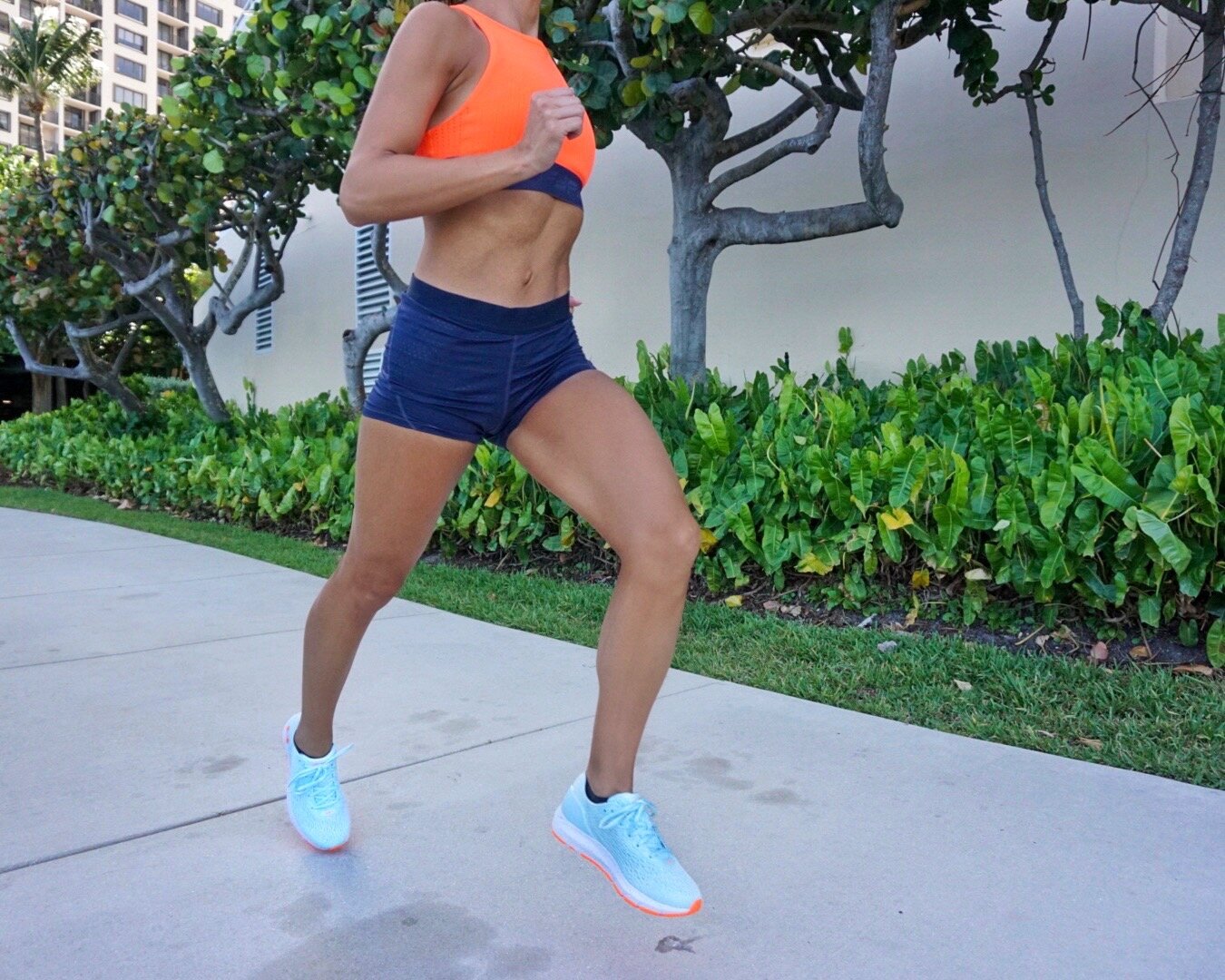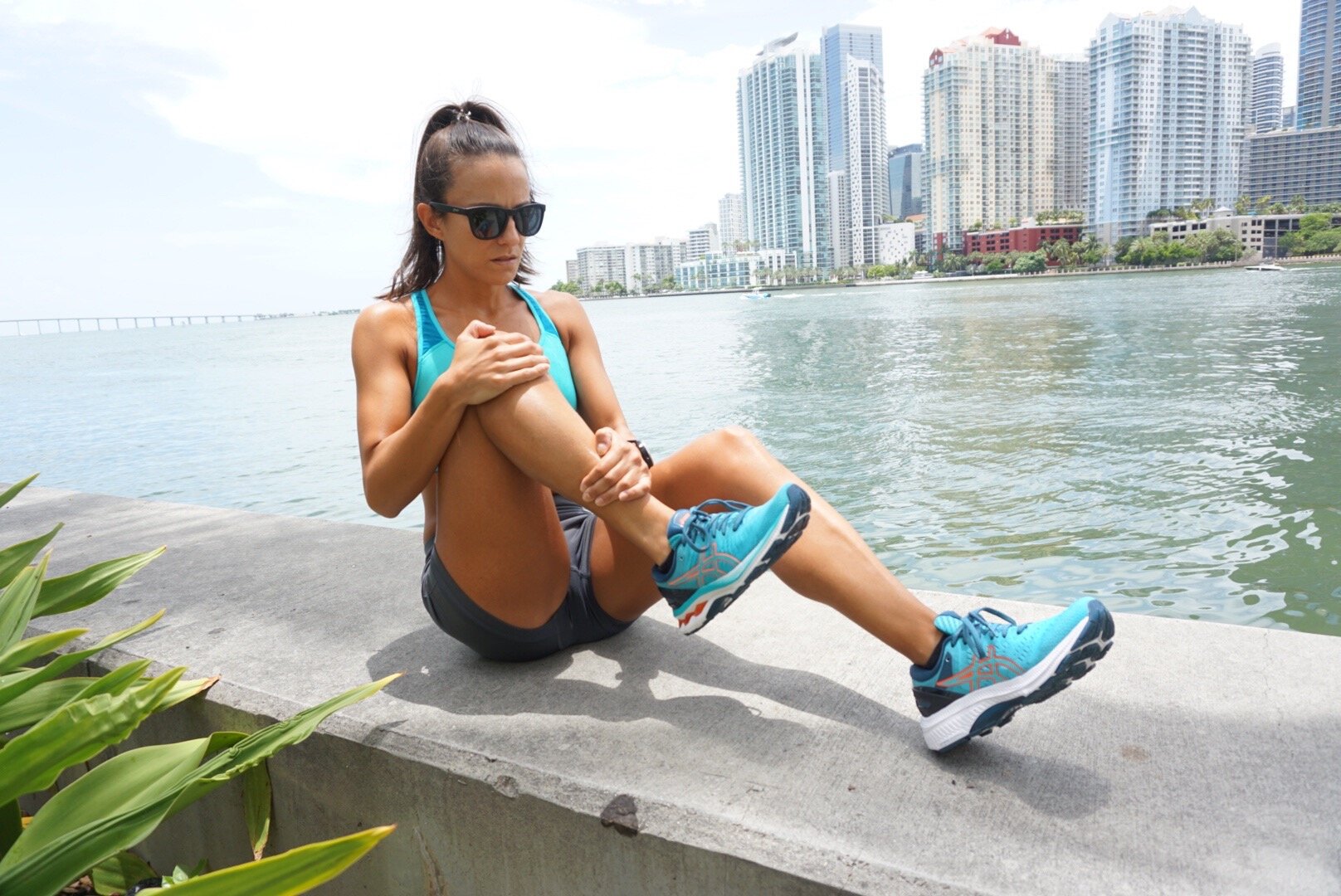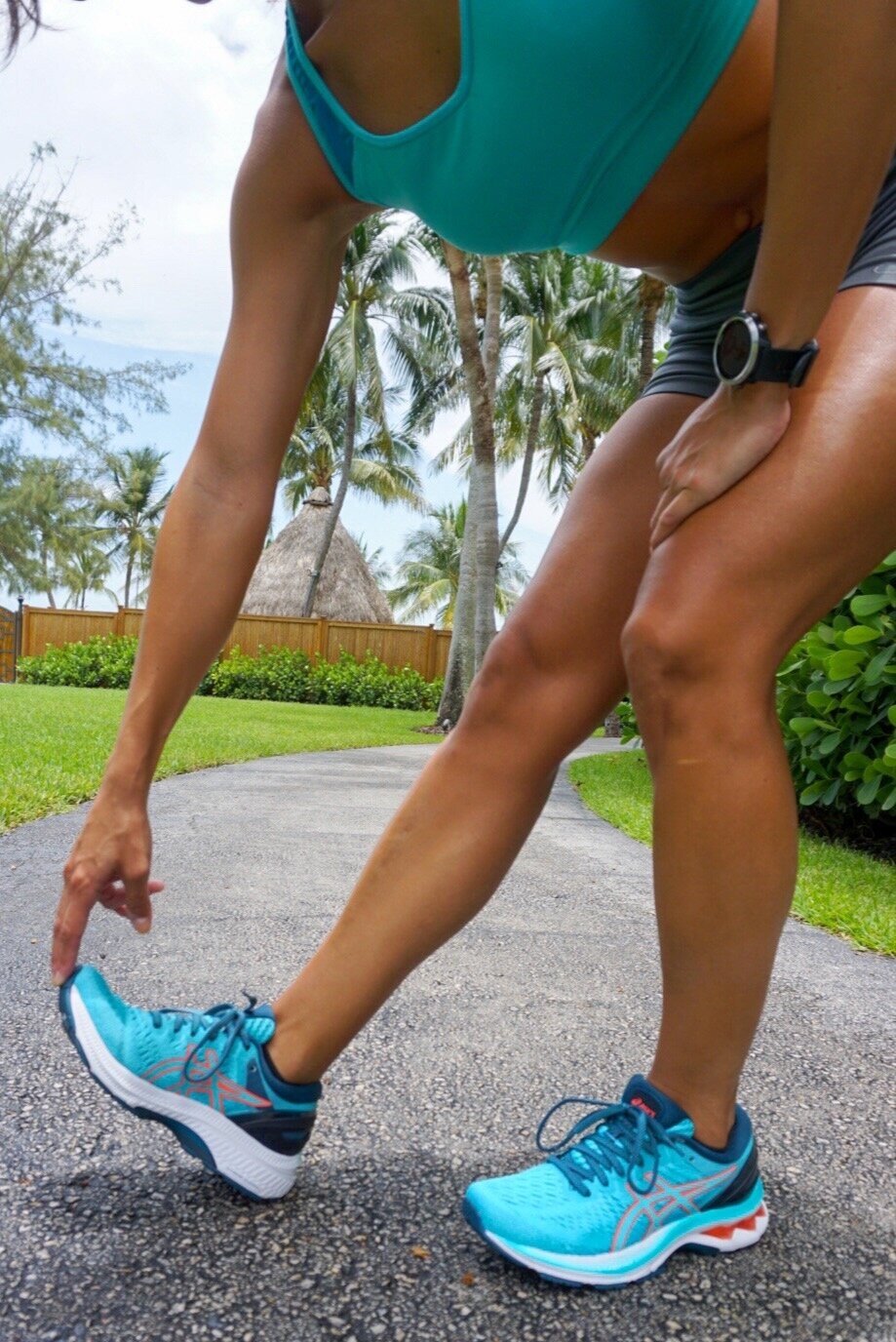It makes sense that foot problems are as common as any other issue in runners since it’s the body part that carries the most weight. It’s the first point of impact, too, so you can imagine how it looks on the inside with the dozens of components that make up just one foot. Yikes! Well, plantar fasciitis is on the top of the list of common running injuries and usually the most frustrating one to deal with. Read on to learn more about how I healed mine for good.
Read moreSingle Leg Exercises for Better Running
Strength training for runners does not have to be complicated, but it sure does need to be selective if you want to see results in your performance and lower your injury risk. Single leg exercises are the way to go. Continue reading to learn why and get some sample workouts to start incorporating today.
Read moreRun Fast and Recover Faster with Apolla Performance Socks
From racing shoes to headlamps and everything in between, runners can be quite picky about their gear. As time goes on and technology advances, runners want the best of the best to be able to perform well, stay away from injury, and recover as fast as possible. Believe it or not, socks play a significant role in foot health for athletes. They are not just made to add a layer of cushion in between the skin and shoe seams. They can provide the feet, and pretty much every joint up the body, with support and injury prevention no matter what your lifestyle dictates.
Comfort is Always Number One
The first thing we aim for when picking out any piece of an outfit, shoes, or socks, is comfort. Runners, in particular, don’t care as much about looks, as long as they can feel comfortable on their long runs and avoid issues like achy joints, blisters, and heaviness. This all can be solved with a good pair of socks. In comes Apolla Performance. Initially created for dancers, who we can all agree get the most beating to their feet, these styles are equally perfect for any lifestyle. Just recently a research study concluded their effectiveness in reducing force and received the American Podiatric Medical Association Seal of Acceptance.
Apolla Performance socks are all made in the USA with REPREVE, which is certified sustainable yarn. Runners are sure to be happy with the Amp (no-show), the Performance (crew), and the Infinite (mid-calf), since they all provide the perfect thickness to protect from impact, blisters, and moisture, without feeling suffocated in running shoes. Each has energy absorption padding in the heel and ball of the foot which helps cushion during both push-off and landing—the parts of the running cycle that damage the feet the most. If you suffer from plantar fasciitis, you will be grateful for this feature!
Instability is the Enemy
As a physical therapist, I am an advocate for creating the most stable surface during the running cycle. This means being extra picky about the shoes and socks you wear. Weak, overused, or tired ankle and foot muscles can lead to ankle rolls and strains in the tiny muscles of the foot from the constant work when your foot and ankle are not supported well. Apolla Performance socks are made with targeted high compression where you need it the most—around the ankle joint and the arch of the foot. The arch actually has three zones of compression to lift and stabilize, which makes a significant difference if you suffer from plantar fascia issues. In these cases you want to prevent your arch from getting too stretched out, which will end up tugging on your heel bone. It’s a tough condition to treat, so you want to do anything you can to avoid too much pressure to this area!
Work Hard, Recover Harder
The mid-calf Infinite Sock from Apolla Performance is the best choice for both recovery runs and your rest days. Providing your feet and lower legs with compressive support is ideal to help with circulation—the key to recovering faster. This is best done with graduated compression up the calf, which is exactly what this pair provides. Using compression socks during and after runs, especially speed workouts and long runs, is ideal for those suffering from achy calves, shin splints, Achilles tendinitis, and any other foot and ankle conditions. You want good blood flow and comfortable cushioning if you want to be fully ready for your next workout. If you are looking for happy and healthy feet, Apolla Performance has you covered!
Back to Base Building with Asics GT-2009
Sponsored by Zappos. All opinions are my own.
Training for races requires a sequence of steps—phases that can be customized to last as long as you’d like. Since I have been shying away from the virtual races this year, I’ve had the longest “base building” phase ever! It’s not a bad thing since I have definitely improved my overall endurance. The downside of long base building phases turns out to be the increased time on your feet. After all, this phase is really about getting the body used to long distance running, which means our bodies get a bit overused if we aren’t careful with recovery and pacing.
The number one tip I give to my athletes and am very strict about myself is making sure to wear the right shoes for every run. This can make or break your ability to run long and perform your best. It’s a good idea to learn your natural foot strike pattern before trying out different styles of shoes. There are a handful of pairs that I feel protect the feet best if you fall into the category of neutral or overpronation. After having amazing success with ASICS I was lucky enough to get my hands on a pair of the new GT-2000 9 from Zappos. I find almost everything I need for running from Zappos, and you can’t go wrong with their super knowledgeable customer service, speedy shipping (literally 2 days at the most!), and free returns for a year through their rewards program! My ASICS came just in time to start out my next training cycle.
Long Run Dominance
My goal right now is to get myself running long again. It’s what truly helped me during my best training blocks. If you can safely increase your weekly mileage, it is sure to help you set a new PR. By “safely” I mean setting aside enough time to recover in between sessions, taking the majority of your runs easy, and eating enough calories every single day. This does not work for everyone, especially those who have a busy job and family to take care of. Although it’s not impossible to follow a high mileage program, it is certainly not necessary. Many runners do just fine running much less!
The ASICS GT-2000 9 have felt like the perfect pair for endurance runs of any distance. The GEL technology cushioning enhances the shock absorption of the shoe at the heel, which has been a lifesaver for me after several miles, given I am a big heel striker so I need all the cushioning I can get for the impact. The midfoot and forefoot of the shoe is made with a cushioning material called SOLYTE, which provides 20% more shock absorption and is half the weight of standard running shoe foams. This combination is ideal for long runs because you never want a heavy shoe, and you need to be careful with other lightweight shoes because they tend to lack the cushioning and absorption you need to run these long distances without feeling fatigue and resulting in achy feet for days.
Fear Not Pronation
You’ve probably read about how overpronating can create more inefficient running. You can still be fast, but your body sure does have to work harder during certain parts of the running cycle. Unfortunately overpronators are also more at risk of acquiring injuries, such as runner’s knee, IT band syndrome, and plantar fasciitis. One of the best features of the ASICS GT-2000 9 is the combined technology of Guidance Trussic, Guidance Line and Dynamic Duomax that promotes the foot to re-supinate after striking the ground so that the push-off phase can be more efficient. This means your strides will be more powerful and running faster will feel more doable.
Although I am not an overpronator, I still mostly wear stability shoes, since I am very prone to ankle and foot injuries. I often deal with plantar fasciitis and posterior tibialis tendinitis, so having this support from the GT 2000 9 has been helpful in keeping my ankle joint stable during every phase of the running cycle, especially while making turns or running over uneven surfaces. At 10mm, the larger heel drop is definitely a more comfortable option if you are looking to protect your Achilles tendon or have dealt with heel pain. This pair is also lightweight—just under 8oz for women! No need for those extremely unsupportive flats for tempo runs and track workouts! If you are challenging yourself with long distance training or even just casually running to relieve some stress these days, I highly recommend the ASICS GT-2000 9 from Zappos, where you will also find all of your running gear needs!
A Long Run Shoe You Can Count On – The Under Armour HOVR Sonic 3
Sponsored by Zappos. All opinions are my own.
If there is one thing I look for in a long run shoe besides cushioning, it’s flexibility. Nothing feels worse on runs over an hour than a stiff shoe. It leaves me with sore feet for days! Since I am prone to plantar fasciitis and have had a history of several foot and ankle injuries, I have to be a little picky about my running shoes. Most runners should be anyway, especially if they plan on training for a half or full marathon. After all our feet carry our entire bodyweight during any standing activity, so if you don’t take good care of them with supportive shoes, you will risk injuring another area in the body on top of limiting your performance.
I am happy I was able to get my hands on a pair of Under Armour HOVR Sonic 3 from Zappos. With their incredible selection of products, it’s always hard to choose just one pair, but this time I was in search of a good long running shoe and the Sonic 3 sounded perfect! As a Zappos rewards member I get free expedited shipping, so my shoes arrived the very next day after placing my order! Another great perk of the rewards member program besides the excellent customer service and speedy shipping, is the 365-day free return policy. If you haven’t joined yet, you are missing out!
Energy Saving
One of the key factors every runner tries to improve for distance running is endurance. It’s all about the way we teach our bodies to store energy and stay strong in order to last as long as possible. Shoes can have this ability, too, just in a different way. The lightweight technology of the Under Armour HOVR Sonic 3 helps transform the energy we put into our steps into energy released by the shoe for a more powerful and efficient stride. For a while, I made the mistake of wearing the wrong shoes for my long runs—shoes that felt light, yet stiff, and definitely not responsive at all. Switching to the Sonic 3 immediately made this energy-saving feature obvious from the start.
As usual, I took my brand new pair out on my regular Sunday short, easy run to test them out. They really didn’t need much ‘breaking in’, and I was surprised at how flexible they felt since I thought the heel counter would make the shoe feel a bit stiff. The heel counter is a great addition to the shoe for me, personally, because it keeps my foot in place. I tend to get annoyed when my shoes get loose during my runs, and this feature made sure to avoid that problem!
Lasting Comfort
As for long runs, this shoe does exceptionally well. First off, the materials are ideal for the intense heat and humidity I run through every day. The upper not only keeps my feet dry, but it provides a compression-like fit, which hugs my foot throughout my entire run—in the lightest way possible! It’s hard finding a shoe that not only feels light for high mileage, but also cushioned enough to keep my feet from getting sore in the days following. The Under Armor HOVR Sonic 3 is the perfect combination of these two features!
Running Tips Straight from the Gait
We rely heavily on the data from our running watches—cadence, pace, heart rate, etc. It’s a never-ending list that can get overwhelming when trying to improve our performance. What if I told you that your shoes can provide you with this information directly? Yes! The HOVR Sonic 3 are one of Under Armour’s connected gear that you can pair to your Map My Run App to get all of the insights of your gait pattern during different runs. The technology provides you with tips in real-time—like DURING your run, to help you correct faulty patterns that can lead to injuries. I’m constantly trying to work to improve my performance as a runner, so I’m excited to have this feature available to me!
The Under Armour HOVR Sonic 3 is officially part of my long run rotation, with its flexible upper, cushioned and compressive fit, and lightweight materials. I highly recommend this pair if you are looking for a light, neutral shoe for daily runs. Zappos has you covered with 5 sleek color options and super fast shipping when you sign up for the rewards membership! You’ll be sure to find any shoes or gear you are looking for when you shop!
Shoe Review: Asics GEL-Kayano 27
Sponsored by Zappos Running. All opinions are my own.
No races? No problem! You don’t need a race to keep on running. It’s true we find a good amount of motivation when we sign up for a big race, so it’s normal if we are feeling a bit bummed during this time as mostly all races have been canceled for the year. The thing about running that we often forget is that you can do it year round and get good at it, too—whether or not you have a race on the horizon. I, myself, think of other ways to get motivated. I create a list of short term goals for running that get me just as excited as my race goals do, and remind myself that reaching these smaller goals will only lead to better progress when I can finally race again.
Another way I motivate myself is with cool, new running gear. My favorite part of my wardrobe is running shoes, of course! I recently got another brand new pair from Zappos—the Asics GEL-Kayano 27. I shop from Zappos all the time, since they have an amazingly large selection of everything. I am a VIP member which also means I get free, super fast shipping, plus free returns for a year! I always have the best shopping experience and find everything I am looking for.
Next Level Performance
With the many months we have until our next races, it’s a great time to break up the time into different training blocks. One of the best ways to improve in distance running is to focus on the whole package, which takes time! So having lots of it is a good thing! Running in the Asics GEL-Kayano 27 is a perfect option if you are looking for a high-level stability shoe. My first impression of the shoe was how lightweight it is, especially after reading about the different systems that make up the shoe, which I thought would make the shoe feel heavy.
As I usually do with every new pair, I tried out the Kayano 27 for the first time on a short easy run. The first thing I noticed was how conforming the shoe felt during every part of the gait cycle. This is my favorite feature of Asics—the GEL that runs across many of their styles. It’s what lets the shoe move with the foot. Shoes without this feature tend to feel stiff when you push off the ground with the toes. The Kayano 27 does a good job with this transition and provides a springy step.
Built-In Comfort
Since I have a history of ankle and foot injuries and have dealt with plantar fasciitis for almost my whole running life, I try my best to find shoes that have a decent amount of cushioning but still provide the responsiveness I need for speed work. I have a pet peeve with running shoes—shifting of my heel, which is non-existent in the Asics GEL-Kayano 27! The external heel counter of the shoe truly holds the heel in place and makes it feel “locked”, so you can count on these shoes to feel more fitted than most other styles.
The DUOMAX support system is a game changer for those of you who overpronate naturally while you run. It’s what gives the shoe the stability aspect and controls that inward rolling of the foot. Not controlling overpronation during running can lead to a long list of injuries such as direct ankle and foot problems, runner’s knee, IT band syndrome, and low back pain. It’s important for runners to pay attention to this when choosing the right shoe. This pair also has a specially designed trusstic system in the women’s shoe compared to the men’s, with softer foam.
I’m excited to keep using my GEL-Kayano 27 for the bulk of my training since so far I find that they truly protect my feet from the constant impact of my daily running. I highly recommend this pair for medium to long runs at a consistent pace, although they are pretty good at quick pace changes, as well! I’ll keep you all updated as I continue to break them in and use them for different distances and run types. In the meantime, check out all of the colors on the Zappos site and don’t forget about the VIP membership benefits!
Strong Calves for Fast Running
Runners basically require every muscle in their bodies to be strong in order to run well and with less risk of injury. Even knowing this we continue to pick and choose what body parts we feel are more important when fitting in exercise. What ends up happening is we run out of time during our weeks and squeeze in a few squats and lunges, and maybe a couple of core exercises and head on our way to run. One muscle group that is often ignored is the calves, which are composed of two different muscles—the gastrocnemius and soleus muscles. Runners are not the only ones who require these areas to function at their best, but everyone is in need of strong and flexible calves for basic daily activities.
The basic function of the calf muscles is to lift the heels up and shift the body weight onto the toes. This motion is required for pushing off during stepping, whether running or walking, as well as climbing stairs. The other important role of the calves is for circulation. These muscles are in charge of pumping blood and fluids out of the lower legs and up to the heart. They perform this function by compressing the veins around them when contracting, forcing blood upward and out of the area. When the calf muscles are relaxed, especially for prolonged periods of time such as when sitting at work, the veins in the muscles and the surrounding area fill up with blood and fluid causing swelling.
Calves for Runners
The calf muscles are in charge of that final push-off during running to propel our bodies upward and forward. They play a crucial role in our stride length and pace. Since this muscle group is smaller than the other main groups higher up in the legs, the quads, hamstrings, and glutes, they fatigue at a much quicker rate during runs. During long runs and races, our slowed pace may be greatly due to the calves tiring out. Even if the hip flexors are significantly strong to drive our knees high during a stride or our quads strong enough to extend our leading leg far forward to lengthen our stride, our pace gets affected if the calves are too weak and tired to push off efficiently.
Runners must rely on the feet and ankles in order to keep sufficient balance. Running, especially fast running is considered a single leg balance movement, therefore our stability is important in order to master faster paces. The calf muscles play a role in this stability as they provide the strength required to prevent swaying forward. If the calves are not strong enough for this role, the end result is increased stress to the Achilles tendon. The same goes for insufficient strength for the push-off—the Achilles will have to take the load. Achilles tendon issues such as tendinitis and strains can be a prolonged and limiting condition for runners, which may lead to tendon tears—an issue that will leave you out of running for several months to over a year.
Calf Strengthening
Runners should incorporate exercises for the calf muscles two to three days per week, along with proper stretching techniques after runs. Focusing on both the gastrocnemius and soleus groups and other supporting ankle muscles is key to keeping proper stability in the feet and ankles. Basic standing heel raises are the most common way to strengthen the calves, but since the gastrocnemius group has two heads—the lateral and medial heads, ideally one should also perform heel raises with their toes pointing outwards as well as inwards. To strengthen the soleus muscle group, heel raises should be performed with the knees bent, as in a squat if standing or simply sitting with a dumbbell or other weight over the thighs for added resistance.
To keep the calves flexible, stretching after runs is important. The easiest stretch is to place the balls of the feet on a step, keeping the heel on the ground and lean the body forward. Keeping the knee straight will mostly stretch the gastrocnemius muscles while performing with the knee bent hits the soleus more effectively. Foam rolling is also another great way to break up any adhesions in the muscle groups that are causing tightness. Significantly tight calves are what leads to Achilles tendon strains, therefore runners should emphasize flexibility exercises as much as possible.
Other effective exercises to keep the calves strong and ready for running are plyometrics. Jumping rope, box jumps, squat jumps and any other explosive movements are great additions to your exercise program that will strengthen the fast twitch muscle fibers of the calves and Achilles tendon. Strong fast-twitch fibers are required to perform an efficient push-off during running. Adding in one or two plyometric moves to your warm-up routine before easy runs or in between other exercises is an effective way to incorporate calf strengthening even if you are short on time. If you want to be a fast runner, you must keep in mind that stronger muscles are needed for faster paces.
Sources
Samuel R. Hamner, Ajay Seth, and Scott L. Delp, Muscle Contributions to Propulsion and Support During Running, Journal, Jul 22, 2018
Injury Prevention 101
We all know that runners have a higher risk of injury than non-runners, just as do athletes of any other sport. Obviously this is true, as simply being more active means you are on your feet more often with a greater availability to trip over an object and fall, step on uneven surface and roll an ankle, or just overuse weak body parts. In my opinion this risk is better than being inactive and risking developing heart disease, diabetes, and other health issues that come from lack of exercise. Besides being cautious to avoid tripping and bumping into something, runners, and all other endurance athletes, should follow other steps to decrease their injury risk on a daily basis.
SLEEP & Rest
The first and most important method to help prevent injury is to make sure you are getting enough sleep. You may feel like your 4 or 5 hours of sleep every night is just fine to keep you going, but sleep does much more than help us get through our day. Most, if not all, of the muscle damage repair and growth occurs during sleep. Human growth hormone is released during certain stages of sleep that increase blood flow to our muscles so that they can repair from our workouts. Another stage of sleep, REM, is responsible for relaxing our muscles and reducing symptoms of chronic pain. Runners should aim for at least 7 hours of sleep each night, but research shows 9 or more hours gives the most benefit to competitive athletes.
Strength Training
A well-rounded exercise plan is always best when it comes to lowering your risk of overuse injuries. You’ve probably read that triathletes, even those who participate in Iron Man competitions, have a lower risk of injury than marathoners. That’s because triathletes train with a balanced mix of running, cycling, and swimming. As a distance runner, if all you are doing is running, then you are inching your way closer and closer to an injury every day. The best formula for runners is to incorporate a mix of running, weight lifting, and other cross training cardio exercises. Lack of time may be the reason most runners skip strength training, but you can highly benefit from a quick 20 to 30 minute session a few days per week. This should be a priority if your goal is to improve your performance and not get injured.
Pack on the Miles GRADUALLY
One of the quickest ways to get injured as a runner is to increase weekly mileage by a substantial amount—even if you’re feeling great. The rule of thumb is to never increase by more than 10% each week. This may even be too much for some runners. A safe method is to increase by a handful of miles each week for 3 to 4 weeks and then have one week as “recovery” where you drop your mileage by 20% to let your body rest. After this recovery week, you can safely start back from where you left off.
Rotate Your Shoes
Since the feet carry your entire body weight during all activities, it is beneficial to give this part of the body a break. One way to do this is to switch your shoes throughout the week. Most brands make running shoes for different types of workouts. Save your well-cushioned shoes for long runs and recovery runs, and your lighter pairs for speed and track sessions. The style of each shoe is different which means your foot muscles will work differently in each pair. Everything that happens down in the feet has an effect on the rest of the body—so shoe rotation lets different muscles all over the body work and rest all at different times.
Focus on Good Form
The constant pounding on the ground from running has an impact on the entire body. The ideal running form is one that lessens this impact and keeps all parts in sync and balanced. It is beneficial to add strides once or twice a week to focus on this. Run 5 sets of 20 to 30 seconds at a hard pace where you practice holding an upright posture with relaxed shoulders, taking quick steps, landing on the mid-foot, and a having a slightly forward lean—all aspects of proper form. Once you master good running mechanics, you will lower your risk of overusing any part of your body.
Stretch & Foam Roll
Just like weak muscles are prone to overuse injuries, tight muscles are more prone to tearing—which is an injury that can put you out for months! Runners can get tight all over, but hamstrings and calves/Achilles are the common areas that get torn. My advice is to make it a habit to stretch after EVERY SINGLE RUN for 10 minutes. A few sets of 20 second holds for the glutes, hamstrings, quads, and calves is enough. Foam rolling can be more tedious but is useful to tackle much deeper muscular tightness. It may also help improve range of motion that is limited by chronic muscle inflammation.
These steps may seem like a large load added onto your regular running routine, but they are necessary if you want to run for years without worrying about easily getting injured. These components will also help you become a more efficient and faster runner over time, so it’s a win-win if you ask me!
Sources
How Sleep Adds Muscle. The National Sleep Foundation. www.sleep.org. Nov 15, 2019.
Achilles Issues & How to Fix Them
Some muscles work harder than others during running. One of these star players is the calves. Well, they pretty much work during every movement we do. Crossing both the ankle joint and knee joint, the calf is involved with any activity that requires us to push off of our toes. Not only that but they are also highly active when trying to control our descent during downhill running or walking. Since they play key roles during every part of running, we should be taking very good care of them every day. Strengthening and stretching the calves on a regular basis is an important part of training.
Having limited strength and flexibility in the calves leads to numerous injuries and pain including shin splints, plantar fasciitis, tendonitis, knee issues, and even hip and back issues over time. One common injury experienced by runners and many other athletes is Achilles’ tendinitis. The Achilles tendon is a thick band that connects the calf muscles to the heel of the foot. It is a prominent tendon in most people. All of the forces generated during running, especially during the push-off phase, are transmitted to the Achilles’ tendon. Faster running usually transmits more forces leading to injuries in the area.
What is Achilles’ Tendinitis?
When there is increased strain to the Achilles’ tendon, inflammation, irritation, and degeneration occur. The overworking of the tendon creates tiny microtears that weaken over time and can eventually lead to larger tears and ruptures. The most notable symptoms of Achilles’ tendinitis is visible swelling in the tendon, tenderness, and pain when first getting in up in the morning and when trying to stand on toes. Once it is warmed up the pain will usually subside and runners are able to run through it. As the condition worsens, the pain will gradually reappear and eventually limit the volume and speed of running. Tendon tears and ruptures will either have a visible bump over the area and commonly a gap where the tendon is ruptured.
Biomechanics
Although high volume training, speed training, and lack of strength are all causes of Achilles’ tendon issues, many physiological and biomechanical factors can increase the strain on the tendon and risk developing these problems.
Foot Strike
You have probably heard about how terrible heel striking is for runners. Well, the truth is that the research is inconclusive and heel striking actually works for some people. The reason this type of foot strike is related to Achilles’ tendon pain is that it involves increased stretching of the tendon. So if you already have tight calves to begin with, then the constant pulling during heel striking can lead to overstretching. The opposite type of foot strike, forefoot striking, actually creates a worse strain on the Achilles’ tendon. With this motion, you are basically landing on the toes and pushing off for the next stride all without giving the calves a break.
Pronation
Foot form is different for everyone. Flat-footed people or those with pronated feet (foot is turned inward when standing) will have a more strained Achilles’ tendon, as well as impeded blood flow to the area. There is already an area with limited blood supply, termed the “watershed area”, where the majority of tendon ruptures occur. This area is located about 4cm above the end point of the tendon on the heel. Limiting blood flow further as in the case of pronation will increase the risk of damage and slow healing on the tendon. Using supinated running shoes or inserts to decrease the amount of pronation is a treatment strategy.
Treatment & Prevention
Runners should focus on incorporating calf strengthening a couple of times every week, especially during their training seasons. Heel raises in all planes—toes pointed straight, toes pointed inward, and toes pointed outward are the main exercise for the calves. Seated heel raises or while in a squat position will help strengthen the soleus muscle, which is a muscle found deep under the gastrocs, the main calf muscles, that also connects to the Achilles’ tendon. Eccentric heel raises are the best way to strengthen the calf muscles as this will prepare the tendon for activities in which it is required to control the descent from extreme positions. To perform eccentric heel raises follow these steps:
Stand on a step with both heels hanging off.
Lift both heels together.
Once completely on toes, shift all weight to only one leg and slowly lower the heel to just below the edge of the step.
Repeat 10-20 times on one leg, then repeat the same with the other leg.
Essentially this exercise will create a type of damage in the tendon, which strips away the previously damaged fibers and encourages the development of new fibers as a form of healing.
Runners should also incorporate stretching after every run and activity that highly involves the Achilles’ tendon such as hiking and climbing stairs. Stretching with both the knee straight and bent is important in order to include both the gastric and soleus muscles. Foam rolling is also helpful to break up any adhesions and extreme tightness in the muscles. Although strength training is time-consuming during training season, it is very important in order to prevent injuries. Achilles’ tendon injuries can be frustrating as they are frequently overlooked since the initial stages involve pain-free running. Taking care of Achilles’ issues from the start will involve a short rehab time while waiting until the pain is unbearable and affecting your running can leave you out of the sport for several months.
Sources:
Răzvan Aniţaş And Dan Lucaciu, A Study Of The Achilles Tendon While Running, Journal, Sep 07, 2018


